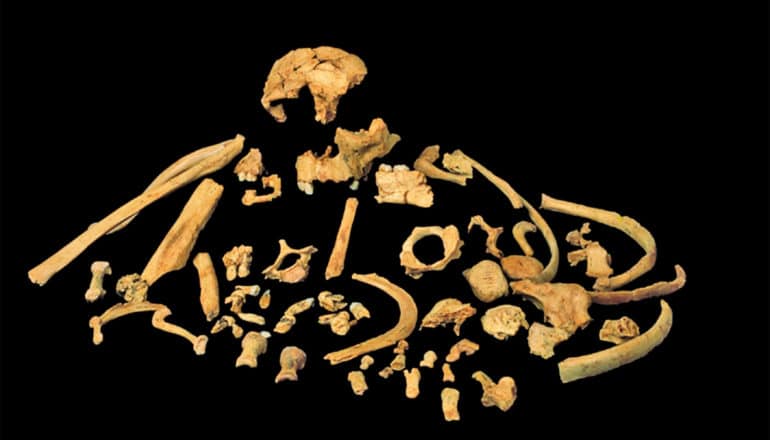
Researchers report retrieving genetic data from an 800,000-year-old human fossil.
The research sheds light on one of the branching points in the human family tree, reaching much further back in time than previously possible.
Researchers retrieved the human genetic data set from an a tooth belonging to the hominin species Homo antecessor.
“Ancient protein analysis provides evidence for a close relationship between Homo antecessor, us (Homo sapiens), Neanderthals, and Denisovans. Our results support the idea that Homo antecessor was a sister group to the group containing Homo sapiens, Neanderthals, and Denisovans,” says first author Frido Welker, a postdoctoral research fellow at the Globe Institute at the University of Copenhagen.

Where does Homo antecessor sit in our family tree?
By using a technique called mass spectrometry, researchers sequenced ancient proteins from dental enamel, and confidently determined the position of Homo antecessor in the human family tree.
The new molecular method, palaeoproteomics enables scientists to retrieve molecular evidence to accurately reconstruct human evolution from further back in time than ever before.
The chimpanzee is the closest living relative to the modern human. The human and the chimpanzee lineages split from each other about 9-7 million years ago. Scientists have relentlessly aimed to better understand the evolutionary relations between our species and the others, all now extinct, in the human lineage.
“Much of what we know so far is based either on the results of ancient DNA analysis, or on observations of the shape and the physical structure of fossils. Because of the chemical degradation of DNA over time, the oldest human DNA retrieved so far is dated at no more than approximately 400,000 years,” says lead author Enrico Cappellini, associate professor at the Globe Institute.
“Now, the analysis of ancient proteins with mass spectrometry, an approach commonly known as palaeoproteomics, allow us to overcome these limits,” he adds.
Comparing genetic data
In 1994, co-corresponding author José María Bermúdez de Castro and his team found the fossils the researchers analyzed in stratigraphic level TD6 from the Gran Dolina cave site, one of the archaeological and paleontological sites of the Sierra de Atapuerca, Spain.
Initial observations led to conclude that Homo antecessor was the last common ancestor to modern humans and Neanderthals, a conclusion based on the physical shape and appearance of the fossils. In the following years, the exact relation between Homo antecessor and other human groups, like ourselves and Neanderthals, has been discussed intensely among anthropologists.
Although the hypothesis that Homo antecessor could be the common ancestor of Neanderthals and modern humans is very difficult to fit into the evolutionary scenario of the genus Homo, new findings in TD6 and subsequent studies revealed several characters shared among the human species found in Atapuerca and the Neanderthals. New studies confirmed that the facial features of Homo antecessor are very similar to those of Homo sapiens but very different from those of the Neanderthals and their more recent ancestors.
“I am happy that the protein study provides evidence that the Homo antecessor species may be closely related to the last common ancestor of Homo sapiens, Neanderthals, and Denisovans. The features shared by Homo antecessor with these hominins clearly appeared much earlier than previously thought. Homo antecessor would therefore be a basal species of the emerging humanity formed by Neanderthals, Denisovans, and modern humans,” adds José María Bermúdez de Castro, scientific co-director of the excavations in Atapuerca.
“This study is an exciting milestone in palaeoproteomics. Using state of the art mass spectrometry, we determine the sequence of amino acids within protein remains from Homo antecessor dental enamel. We can then compare the ancient protein sequences we ‘read’ to those of other hominins, for example Neanderthals and Homo sapiens, to determine how they are genetically related,” says Jesper Velgaard Olsen.
“I really look forward to seeing what palaeoproteomics will reveal in the future,” concludes Cappellini.
The study of human evolution by palaeoproteomics will continue in the coming years through the recently established, EU-funded “Palaeoproteomics to Unleash Studies on Human History (PUSHH)” Marie S. Curie European Training Network (ETN), led by Enrico Cappellini, and involving many of the coauthors of the paper.
The study appears in Nature. Additional researchers from the University of Copenhagen and the CENIEH (National Research Center on Human Evolution) in Burgos, Spain contributed to the work.
VILLUM FONDEN, the Novo Nordisk Foundation, and the Marie Sklowowska-Curie actions “Individual Fellowship” and “Innovative Training Network” programs funded the research.
Source: University of Copenhagen
The post Oldest human genetic data may expand our ‘family tree’ appeared first on Futurity.
from Futurity https://ift.tt/2w7X0vz
No comments:
Post a Comment